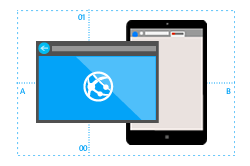Ionic HTML5 and Angular
Sample Mobile Application with Ionic and AngularJS February 5, 2014 in Angular.js, Cordova, Ionic, PhoneGap
Ionic and Angular 2 | The Official Ionic Blog
blog.ionic.io/angular-2-ionic
Hey Ionites, After a hugely successful ngConf last week, the Ionic office is abuzz with Angular 2, and what it means for Ionic. The number one response from ngConf is that Angular is here to stay, and …
5 Best Mobile Web App Frameworks: Ionic (AngularJS) - Modus Create
moduscreate.com/5-best-mobile-web-app-frameworks
Ionic framework is the youngest in our top 5 stack, as the alpha was released in late November 2013. Built on top of the popular AngularJS framework from Google, Ionic utilizes AngularJS to provide …
Javascript - Extend Ionic even further with the power of AngularJS ...
ionicframework.com/docs/api
Ionic makes it incredibly easy to build beautiful and interactive mobile apps using HTML5 and AngularJS. ... Learn more about how Ionic was built, why you should use it, and what's included. …
ionic-angular - npm
https://www.npmjs.com/package/ionic-angular
Usually, the only import required by the user is ionic-angular, as everything from Ionic is exported by the package: import { App, NavController } from 'ionic-angular'; Bundles. Minified and unminified …
Ionic in Action: Hybrid Mobile Apps with Ionic and AngularJS
www.amazon.com › … › Web Development & Design
Ionic in Action teaches web developers how to build cross-platform mobile apps for phones and tablets on iOS and Android. You'll learn how to extend your web development skills to build apps …
Create Your First Mobile App with AngularJS and Ionic | Scotch
https://scotch.io/tutorials/create-your-first-mobile-app-with...
Angular 2 is the shiny new framework that comes with a lot of new concepts. Learn all the great new features. In the past years, making a mobile app involved being good with the native language you …
Angular 2 Series: Introduction | The Official Ionic Blog
blog.ionic.io/angular-2-series-introduction
README: Angular 2 has changed significantly since this post was written. As such, please do not use this code verbatim. Instead, focus on the concepts below and then map them to the new syntax and API of Angular …
Building a Mobile App with AngularJS 1 and Ionic - Lynda.com
https://www.lynda.com/AngularJS-tutorials/Building-Mobile-App...
Watch video · - [Voiceover] Hey there, this is Ray Villalobos, staff author at lynda.com and I want to welcome you to Building a Mobile App with AngularJS and Ionic. In this course, I'm going to show …
Sample Mobile Application with Ionic and AngularJS February 5, 2014 in Angular.js, Cordova, Ionic, PhoneGap
Ionic and Angular 2 | The Official Ionic Blog
blog.ionic.io/angular-2-ionic
Hey Ionites, After a hugely successful ngConf last week, the Ionic office is abuzz with Angular 2, and what it means for Ionic. The number one response from ngConf is that Angular is here to stay, and …
5 Best Mobile Web App Frameworks: Ionic (AngularJS) - Modus Create
moduscreate.com/5-best-mobile-web-app-frameworks
Ionic framework is the youngest in our top 5 stack, as the alpha was released in late November 2013. Built on top of the popular AngularJS framework from Google, Ionic utilizes AngularJS to provide …
Javascript - Extend Ionic even further with the power of AngularJS ...
ionicframework.com/docs/api
Ionic makes it incredibly easy to build beautiful and interactive mobile apps using HTML5 and AngularJS. ... Learn more about how Ionic was built, why you should use it, and what's included. …
ionic-angular - npm
https://www.npmjs.com/package/ionic-angular
Usually, the only import required by the user is ionic-angular, as everything from Ionic is exported by the package: import { App, NavController } from 'ionic-angular'; Bundles. Minified and unminified …
Ionic in Action: Hybrid Mobile Apps with Ionic and AngularJS
www.amazon.com › … › Web Development & Design
Ionic in Action teaches web developers how to build cross-platform mobile apps for phones and tablets on iOS and Android. You'll learn how to extend your web development skills to build apps …
Create Your First Mobile App with AngularJS and Ionic | Scotch
https://scotch.io/tutorials/create-your-first-mobile-app-with...
Angular 2 is the shiny new framework that comes with a lot of new concepts. Learn all the great new features. In the past years, making a mobile app involved being good with the native language you …
Angular 2 Series: Introduction | The Official Ionic Blog
blog.ionic.io/angular-2-series-introduction
README: Angular 2 has changed significantly since this post was written. As such, please do not use this code verbatim. Instead, focus on the concepts below and then map them to the new syntax and API of Angular …
Building a Mobile App with AngularJS 1 and Ionic - Lynda.com
https://www.lynda.com/AngularJS-tutorials/Building-Mobile-App...
Watch video · - [Voiceover] Hey there, this is Ray Villalobos, staff author at lynda.com and I want to welcome you to Building a Mobile App with AngularJS and Ionic. In this course, I'm going to show …



